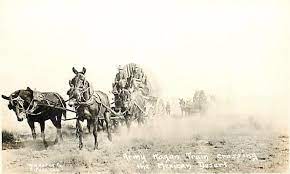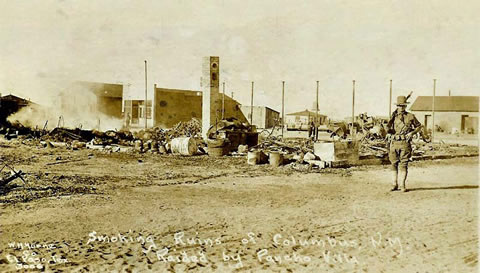 The clock at the Columbus train station, stopped at the time of the attack by a bullet. It is now in the museum at Pancho Villa State Park.
The clock at the Columbus train station, stopped at the time of the attack by a bullet. It is now in the museum at Pancho Villa State Park.Today marks the 106th anniversary of Pancho Villa's raid on Columbus, New Mexico. On March 9, 1916, at approximately 4:00 am, a group of just under 500 Mexican revolutionaries attacked the sleeping town while their leader, General Francisco “Pancho” Villa, watched from a nearby hill. The attack was the first and only ground invasion of the continental United States since the War of 1812. Ten American civilians and eight U.S. soldiers from the adjacent Camp Furlong lost their lives.
The attack came after a long period of Mexican political unrest and may have been caused by Villa's frustration that President Woodrow Wilson and the American government had chosen to recognize a political rival, Venustiano Carranza, and help him win the election and become President of Mexico. Villa, who had been supported by the U.S. in the past, was also desperate supplies for his beleaguered army and may have thought that Columbus and the nearby Army camp would be a good place to get what he needed.
The attack came after a long period of Mexican political unrest and may have been caused by Villa's frustration that President Woodrow Wilson and the American government had chosen to recognize a political rival, Venustiano Carranza, and help him win the election and become President of Mexico. Villa, who had been supported by the U.S. in the past, was also desperate supplies for his beleaguered army and may have thought that Columbus and the nearby Army camp would be a good place to get what he needed.

In response, Wilson ordered a punitive expedition into Mexico to capture Villa. General John J. Pershing began gathering troops at Camp Furlong (sometimes called Camp Columbus). Pershing planned a two-pronged attack. The quicker force, of mostly soldiers on horseback, went south from the village of Hachita, in New Mexico's bootheel. The slower force, which included wagons and trucks filled with gear and supplies, went south directly from Columbus.
By April 8th, General Pershing's force of over six thousand had traveled four hundred miles into Mexico. There they established a base in the town of Colonia Dublan. The U.S. Army had never before attempted anything of this magnitude, and the logistics of supplying Camp Dublan proved difficult.
President Wilson had assumed that the Mexican government would support a raid intended to capture Pancho Villa. Instead, Mexico refused to offer the U.S. expedition any aid. This included denying the U.S. the use of the Mexican Northwestern Railway to transport supplies. Food and supplies were brought in by horse and mule trains. Soon, the whole operation was at a standstill.
By April 8th, General Pershing's force of over six thousand had traveled four hundred miles into Mexico. There they established a base in the town of Colonia Dublan. The U.S. Army had never before attempted anything of this magnitude, and the logistics of supplying Camp Dublan proved difficult.
President Wilson had assumed that the Mexican government would support a raid intended to capture Pancho Villa. Instead, Mexico refused to offer the U.S. expedition any aid. This included denying the U.S. the use of the Mexican Northwestern Railway to transport supplies. Food and supplies were brought in by horse and mule trains. Soon, the whole operation was at a standstill.
 Jeffery quads in Mexico.
Jeffery quads in Mexico.When U.S. Secretary of War Newton Baker found out about this dilemma, he found $450,000 of unappropriated funds and purchased 27 new trucks. The Jefferys had four wheel drive, and were as tough as mules. Even with the trucks, moving supplies was not easy. Many of the roads depicted on available maps proved to be no more than trails that became impassable when wet. Army engineers found themselves busy rebuilding roads and restringing cut telegraph lines.
 Officers breakfast, Camp Dublan
Officers breakfast, Camp DublanThe situation came to a head in the middle of April, when a detachment of troops from Carranza's army attacked the American troops at Parral. The Americans were able to drive back the Mexicans, killing fourteen of them, but one American was killed, and one wounded. From then on, Pershing kept the majority of his men at Camp Dublan, sending out only small scouting parties and detachments to locate Villa.

By February 1917, the Punitive Expedition to Mexico was over. Newton D. Baker, claimed that the Expedition had “fully and finally accomplished . . . a display of the power of the United States into a country disturbed beyond control of the constituted authorities of the Republic of Mexico as a means of controlling lawless aggregations of bandits and preventing attacks by them across the international frontier."
General Black Jack Pershing crossed back into the United States and parade triumphantly through the streets of Columbus with 10,690 soldiers and some 2,700 refugees. Two hundred of the refugees were Americans who had owned ranches south of the border. Another five hundred were Chinese immigrants who faced discrimination in Mexico and were moving north in search of a better life. The remaining two thousand were Mexican citizens escaping the violence of their country’s long civil war.
The fact that Pershing’s Army brought back so many refugees proved that Mexico remained a dangerous place. Although depleted by casualties and desertion and not the menace they had been, Pancho Villa and his Villistas were still on the loose.
General Black Jack Pershing crossed back into the United States and parade triumphantly through the streets of Columbus with 10,690 soldiers and some 2,700 refugees. Two hundred of the refugees were Americans who had owned ranches south of the border. Another five hundred were Chinese immigrants who faced discrimination in Mexico and were moving north in search of a better life. The remaining two thousand were Mexican citizens escaping the violence of their country’s long civil war.
The fact that Pershing’s Army brought back so many refugees proved that Mexico remained a dangerous place. Although depleted by casualties and desertion and not the menace they had been, Pancho Villa and his Villistas were still on the loose.

The raid on Columbus and the expedition into Mexico are important parts of the story told in A Blaze of Poppies, Jennifer Bohnhoff's historical novel about life on a ranch in Southern New Mexico. It is available as a paperback or ebook from Amazon, or a signed paperback copy can be purchased directly from the author.






No comments:
Post a Comment